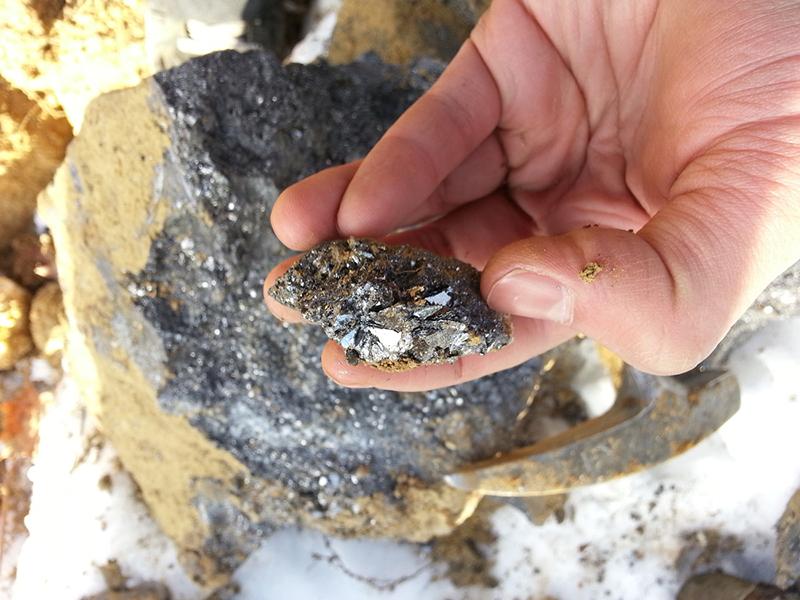Updated January 6, 2017
The municipal council of Grenville-sur-la-Rouge (GSLR) has lent its support to Canada Carbon, a company developing a mine in the municipality. Canada Carbon would mine graphite and quarry marble from a property in the area.
The mine, referred to as the Miller Project, would be on lands which are currently part of provincial agricultural reserves. The company has applied to the province (Commission de Protection du Territoire Agricole du Québec or CPTAQ) in order to able to use the land for something besides agriculture.
On December 13, GSLR’s council supported Canada Carbon’s request with a resolution. The resolution, which was supported unanimously, downplays the agricultural potential of the land and recommends supporting Canada Carbon’s request to CPTAQ by recommending it approve Canada Carbon’s request for permission to use the land for non-agricultural purposes.
Mayor John Saywell says it’s just one step in a longer approval process. He said in order for a request to be considered by the CPTAQ, a project needs a resolution from the local municipality saying it has no objection. “That doesn’t mean we’ll approve the project, it just means it’s worth their while to go ahead and get the board’s authorization,” said Saywell. As part of the process, public consultations will be held in March 2017, he said.
The project would include the former Miller Mine, which was operational around 1845 and may have been the first graphite mine in Canada, says Canada Carbon. The company is touting the property as a source for very pure graphite, which has potential applications in nuclear energy. In September, for example, Canada Carbon published a press release saying it was holding discussions with an American company called X Energy to supply graphite which would be used as a component for fuel for nuclear reactors.
The company also has claims on about 100 square kilometres of land in the municipality. That includes an area where the municipality is planning to develop a park. The claim doesn’t change the plan, said Saywell. “That would be one of the most important areas of the whole Outaouais region,” he said. “If there’s going to be mining it’s not going to be in the highest profile and highest value recreation property of the region. That’s not something we’re considering now. My understanding is that they have made a statement to the effect that they understand the value of the land and they have no interest in pursuing claims in that area,” he said.
Bruce Duncan, CEO of Canada Carbon, says the company plans to mine only in a .29 square-kilometre area for between 10-15 years. The large amount of claims, he said, are to “preclude anyone else from coming in.” He said between 50 and 100 people could be employed at the mine.

A map of Canada Carbon’s claims and pending claims dated 2014 posted on the company’s website.
Saywell said the municipality is not concerned about the company’s request to use land in the municipality for something besides agriculture. The December 13 resolution says “agricultural potential of the soils observed offers no possibility for cultivation or for permanent grazing and…forest inventory of the subject lands demonstrates that it does not have the production potential of a maple sugar bush.”
A “Technical Report and Preliminary Economic Assessment” prepared for the company, published in March 2016, also said the land does not have much agricultural potential: “results of the soil surveys indicate that the Miller site is not suitable for agricultural use due to poor soil quality, stoniness, and areas with steep slopes and uneven ground,” it says. It also says the property includes six wetlands with “ecological significance ranging from low to high,” as well as one area where maple production could be possible. That report dealt only with Canada Carbon’s claims east of the Rouge River, which cover around 18 square kilometres of property, and are accessible via Scotch Road as well as paths and forestry roads. The report says Canada Carbon has an agreement with a pair of property owners in that area, allowing for prospecting and exploration on the property.”The Miller Property is located on private land and the surface-right owners must be kept informed about upcoming exploration programs. Additionally, Canada Carbon must obtain their permission before initiating any exploration program,” it says.
The municipality will be conducting its own environmental studies, said Saywell. He said noise, dust and water runoff are potential concerns. They will also be looking for help maintaining Scotch Road. “It’s on a road that needs repair and rebuilding, so one of our discussions with them is what is the volume of traffic on the road and how much effort they’ll put in the rebuilding of the road as a pre-requisite to having the mine open up,” said Saywell, adding the municipality hopes to “make a win-win situation out of it.”
Overall, he said council believes Canada Carbon’s project could benefit the municipality. “From what we’re told, average salaries in the mining industry are way over what quarry jobs are, or other industrial jobs are” in the area, he said. The resolution from December 13, approved unanimously by council, says Canada Carbon’s project “will generate major economic benefits for local and regional communities.” Saywell did not vote on the resolution, but said as mayor, he doesn’t usually vote.
A statement published on Canada Carbon’s website says depending on the results of a feasibility study, “full graphite mining” production would begin in December, 2017. In a statement included in a press release about GSLR’s resolution, CEO Bruce Duncan says council’s support “is a significant milestone in the permitting process required for the development of the Miller Project. Their unanimous approval will provide foundational support as we proceed with project permitting.”


